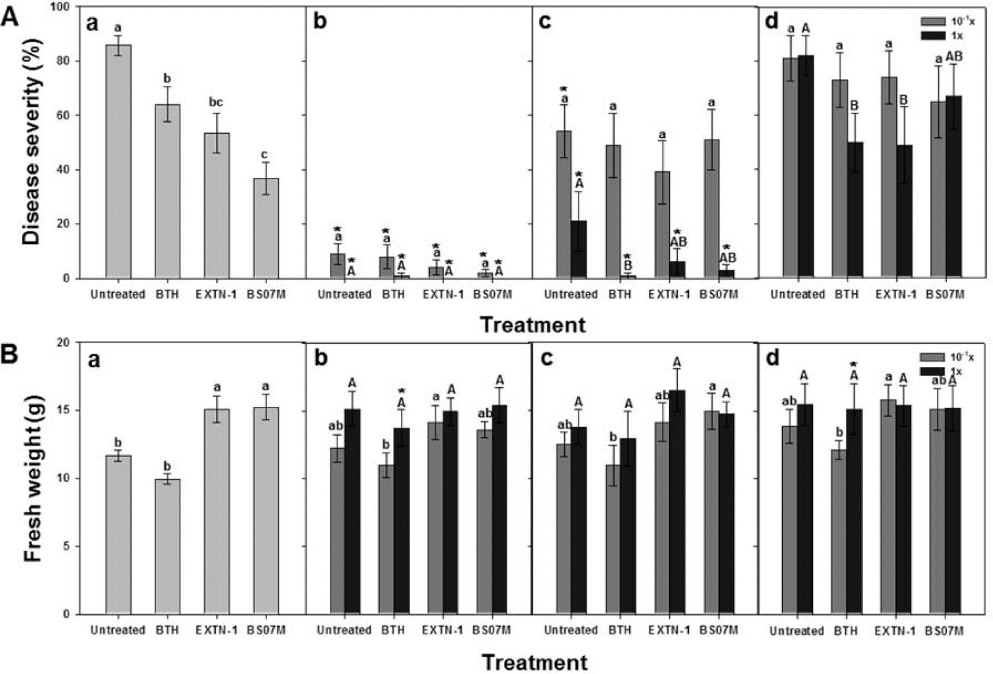Ahemad, M. and Khan, M. S. 2012. Effect of fungicides on plant growth promoting activities of phosphate solubilizing
Pseudomonas putida isolated from mustard (
Brassica compestris) rhizosphere.
Chemosphere 86: 945-950.


Bais, H. P., Weir, T. L., Perry, L. G., Gilroy, S. and Vivanco, J. M. 2006. The role of root exudates in rhizosphere interactions with plants and other organisms.
Annu. Rev. Plant Biol 57: 233-266.


Dutta, S. and Podile, A. R. 2010. Plant growth promoting rhizobacteria (PGPR): the bugs to debug the root zone.
Crit. Rev. Microbiol 36: 232-244.


Fukusawa, K., Sakurai, H., Shimizu, S., Naganawa, H. and Kondo, S. 1980. 3-Phosphoryldihydro-streptomycin produced by the inactivating enzyme of
Erwinia carotovora.
J. Antibiot 33: 122-123.

Gerhardson, B. 2002. Biological substitutes for pesticides.
Trends Biotechnol 20: 338-343.


Huang, T. C. and Burr, T. J. 1990. Characterization of plasmids that encode streptomycin-resistance in bacterial epiphytes of apple.
J. Appl. Microbiol 86: 741-751.

Hyun, J.-W., Kim, H.-J., Yi, P.-H., Hwang, R.-Y. and Park, E.-W. 2012. Mode of action of streptomycin resistance in the citrus canker pathogen (
Xanthomonas smithii subsp.
citri) in Jeju island.
Plant Pathol. J 28: 207-211.

Ishikawa, R., Suzuki-Nishimoto, M., Fukuchi, A. and Matsuura, K. 2004. Effective control of cabbage black rot by validamycin A and its effect on extracellular polysaccharide-production of
Xanthomonas campestris pv.
campestris.
J. Pestic. Sci 29: 209-213.

Jacobsen, B. J., Zidack, N. K. and Larson, B. J. 2004. The role of Bacillusbased biological control agents in integrated pest management systems: Plant diseases.
Phytopathology 94: 1272-1275.


Kwon, H. R., Choi, G. J., Choi, Y. H., Jang, K. S., Sung, N.-D., Kang, M. S., Moon, Y., Lee, S. K. and Kim, J.-C. 2009. Suppression of pine wild disease by an antibacterial agent, oxolinic acid.
Pest Manag. Sci 66: 634-639.


Levene, H. 1960. Contributions to Probability and Statistics: Essays in Honor of Harold Hotelling. Stanford University Press, Stanford, CA.
Obradovic, A., Jones, J. B., Momol, M. T., Olson, S. M., Jackson, L. E., Balogh, B., Guven, K. and Iriarte, F. B. 2005. Integration of biological control agents and systemic acquired resistance inducers against bacterial spot on tomato.
Plant Dis 89: 712-716.


Park, K. S., Diby, P., Kim, Y. K., Nam, K. W., Lee, Y. K., Choi, H. W. and Lee, S. Y. 2007. Induced systemic resistance by
Bacillus vallismortis EXTN-1 suppressed bacterial wilt in tomato caused by
Ralstonia solanacearum.
Plant Pathol. J 23: 22-25.

Park, K. S., Paul, D., Ryu, K. R., Kim, E. Y. and Kim, Y. K. 2006a. Bacillus vallismortis strain EXTN-1 mediated systemic resistance against Potato Virus X and Y (PVX &PVY) in the field. Plant Pathol. J 22: 360-363.
Park, K. S., Paul, D. and Ye, W. H. 2006b. Bacillus vallismortis EXTN-1 mediated growth promotion and disease suppression in rice (Oryza sativa L.). Plant Pathol. J 22: 278-282.
Park, J.-W., Balaraju, K., Kim, J.-W., Lee, S.-W. and Park, K. 2013. Systemic resistance and growth promotion of chili pepper induced by an antibiotic producing
Bacillus vallismortis strain BS07.
Biol. Control 65: 246-257.

Sang, M. K. and Kim, K. D. 2012. The volatile-producing
Flavobacterium johnsoniae strain GSE09 shows biocontrol activity against
Phytophthora capsici in pepper.
J. Appl. Microbiol 113: 383-398.


Sisler, H. D. 1986. Control of fungal diseases by compounds acting as antipenetrants.
Crop Prot 5: 306-313.

Smith, W. L. 1962. Chemical treatments to reduce postharvest spoilage of fruits and vegetables.
Bot. Rev 28: 411-445.

Smith, M. D., Hartnett, D. C. and Rice, C. W. 2000. Effects of longterm antibiotic applications on microbial properties in tallgrass prairie soil. Soil Biol. Biochem 32: 935-946.
Snyder, M. and Drlica, K. 1979. DNA gyrase on the bacterial chromosome: DNA cleavage induced by oxolinic acid.
J Mol. Biol 131: 287-302.


Patricia, S. M., Virginia, O. S., George, W. S. and Alan, L. J. 2002. Antibiotic use in plant agriculture.
Annu. Rev. Phytopathol 40: 443-465.


Ren, J. P., Petzoldt, R. and Dickson, M. H. 2001. Screening and identification of resistance to bacterial soft rot in Brassica rapa. Euphytica 118: 271-280.
Thanh, D. T., Tarn, L. T. T., Hanh, N. T., Tuyen, N. H., Bharathkumar, S., Lee, S. Y. and Park, K.-S. 2009. Biological control of soilborne diseases on tomato, potato and black pepper by selected PGPR in the greenhouse and field in Vietnam.
Plant Pathol. J 25: 264-269.

Vanjildorj, E., Song, S. Y., Yang, Z. H., Choi, J. E., Noh, Y. S., Park, S., Lim, W. J., Cho, K. M., Yun, H. D. and Lim, Y. P. 2009. Enhancement of tolerance to soft rot disease in the transgenic Chinese cabbage (
Brassica rapa L. spp.
pekinensis) inbred line, Kenshin.
Plant Cell Rep 28: 1581-1591.



Whipps, J. M. 2001. Microbial interactions and biocontrol in the rhizosphere.
J. Exp. Bot 52: 487-511.


Wang, Z.-J., Ji, S., Si, Y.-X., Yang, J.-M., Qian, G.-Y., Lee, J. and Yin, S.-J. 2013. The effect of validamycin A on tyrosinase: Inhibition kinetics and computational simulation.
Int. J. Biol. Macromol 55: 15-23.


Yang, C., Hamel, C., Gan, Y. and Vujanovic, V. 2012. Tag-encoded pyrosequencing analysis of the effects of antibiotic application and plant genotype on rhizobacterial communities. Appl. Soil Ecol 60: 92-97.




 PDF Links
PDF Links PubReader
PubReader Full text via DOI
Full text via DOI Download Citation
Download Citation Print
Print






